Despite being short and low, pony walls typically feature top and bottom plates, similar to usual walls. Sometimes the plates are replaced with molding and a baseboard.
In a nutshell, a pony wall is no more than a low wall.
Pony walls can be used both outdoor and indoors. This kind of wall can be used as a foundation or structural wall for exterior use. However, most of the time, pony wall is used indoors.
The main function of the pony wall is to create a separation in an open floor plan. Sometimes, you need a physical border to separate one room and another in an open floor plan, and what’s better than a pony wall to create separation?
Pony wall doesn’t have to be bare and plain, even though some people prefer to use a small amount of decoration in them, some traditional or minimalist designs.
But, if you want your pony wall to be decorative as well as functional, there are many ways to make it look attractive.
The ideas are basically endless, from wainscoting, paneling, or attaching it with glass or slats.
Commonly, pony walls are used in a bathroom or a powder room to separate the shower stall or the toilet from the rest of the bathroom. Yet, pony walls can also be used in other rooms.
Here are some nice-looking ideas for pony wall that you’ll surely like:
- Tiled Covered Pony Wall Idea in a Bathroom
- Pony Walls to Support Decorative Columns in a Powder Room
- Pony Wall Idea to Separate the Open Bathroom and the Bedroom
- Wood-look Tiled Pony Wall with a Tall Glass at the Top
- Pony Wall in a Shower Stall With a Niche
- Pony Wall with a Built-in Bench
- Pony Wall to Separate a Kitchen and a Dining Room
- L-shaped Pony Wall with Two Columns
- Recessed Panel Pony Wall to Cover the Staircase
- A Long White Painted Pony Wall is Attached to the Opening in an Open Room
- Pony Wall with Wide-Gapped Wood Slats
- Open Concept Kitchen with a Wood-topped Pony Wall as a Border
- Decorative Wainscoted Pony Wall as Extra Storage
- White Oak Pony Wall to Separate the Kitchen and the Living Room
- Pony Wall in the Entry to Partially Enclose the Living Space
- Pony Wall in the Entrance to Separate the Mudroom and the Workspace
- Pony Wall to Hide a Toilet in the Bathroom
1. Tiled Covered Pony Wall Idea in a Bathroom

Since this pony wall is installed in the shower stall and meant to partially enclose the shower area, it’s reasonable to cover it with tile.
Tile is an excellent option to cover and protect the bathroom walls from splashes of water.
The tiles used here are the simple 3×6 subway tiles with black trim, repeating the pattern from the main walls of the shower stalls.
Even though this pony wall only partially covers the shower, the designer installed a glass panel on top of it to add extra height. This way, the pony wall can stand tall all the way up the ceiling.
The glass panel is actually the extended part of the shower’s glass door. Glass has a similar characteristic to tiles; it is water resistant. It’s OK for them to get wet because water won’t damage them anyway.
Extending your pony wall with a glass panel is also an excellent way to create privacy and exclude the shower stall from the rest of the bathroom.
2. Pony Walls to Support Decorative Columns in a Powder Room

This is a tropical powder room with a lot of decorations that you usually find in many tropical countries.
The pony wall in this area is simply for a decorative purpose, even though it is useful to separate the toilet from the rest of the area.
But the main reason why it was built was, according to the designer, this area was designed around a pair of African drums. And these drums were used as columns.
The only possible way to make such huge drums stand is by building pony walls as their bases.
You see, there are two pony walls here, even though the second one is way too small to even be considered a wall and mainly used as a column base only.
The bigger pony wall is somehow also useful to hide the toilet, so it’s good to maintain privacy.
Both pony walls are made of a unique slab that the designer found at DaVinci Marble. The tile is also used for the lower part of the powder room’s wall.
The light tan shade works definitely wall as a column base because it contrasts the decorative African drums.
3. Pony Wall Idea to Separate the Open Bathroom and the Bedroom
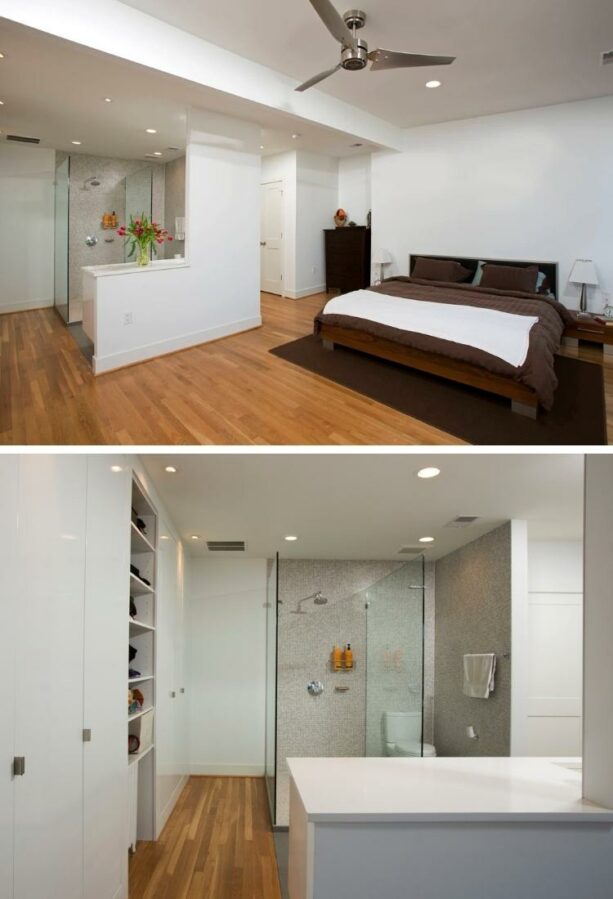
If you want, it’s possible to have a semi-open bathroom in a master bedroom.
Since this is a private bathroom, privacy won’t be an issue anymore. However, somehow you still need a cover, though partially, to separate your bedroom and bathroom area. That’s when the pony wall comes to the rescue.
This pony wall is attached to a half wall, creating a perfect L-shaped design. However, the pony wall seems to have a wider top, and it appears that this pony wall is practically a built-in vanity completed with a countertop.
Such a wide top is useful to be a display rack. That’s why the homeowners put a big vase with bright flowers.
Such bright decoration will surely look pop against the white setting of the pony wall. Even though the bathroom is semi-open, at least the toilet is hidden from the bedroom, thanks to the pony wall.
To keep the simplicity of the white, this pony wall is made of a usual material of the wall, similar to the walls around this bedroom.
4. Wood-look Tiled Pony Wall with a Tall Glass at the Top
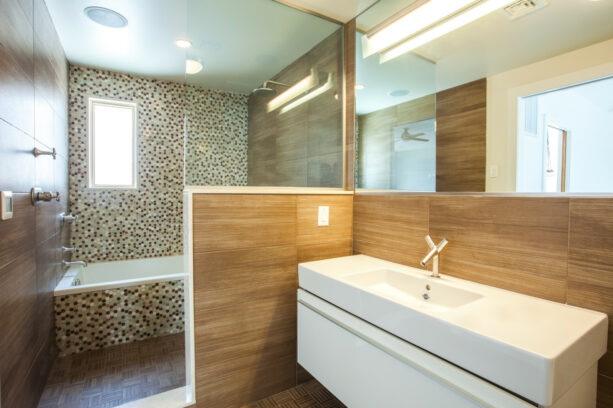
Don’t be deceived. The pony wall in this bathroom (and in the backsplash and the wall in the shower stall, too) are not real woods. They are actually tiles that look like wood.
Remember that wood is a poor and unrecommended material for bathrooms because it can absorb moisture, and moisture will make it easily rot.
But that doesn’t mean you can incorporate a charm of wood in your bathroom. One of the genius ways is by using the wood-look tiles like this.
This pony wall is made of that kind of tile, similar to the backsplash, to create a consistent look. You see that the tile perfectly imitates wood. It even has a horizontal grain that you usually find in white cedar.
The medium tone really sets the mood for the entire bathroom, making it warm and soft.
The pony wall has a white trim that seems to be made of vinyl. This white trim accentuates the tile and makes it look more prominent. This pony wall was built because it is meant to separate the bath area and the vanity.
Adding a tall glass panel on top of a pony wall is a common design in a bathroom. The glass panel is versatile because it works as a divider, adding extra height to the pony wall and maintaining privacy.
5. Pony Wall in a Shower Stall With a Niche
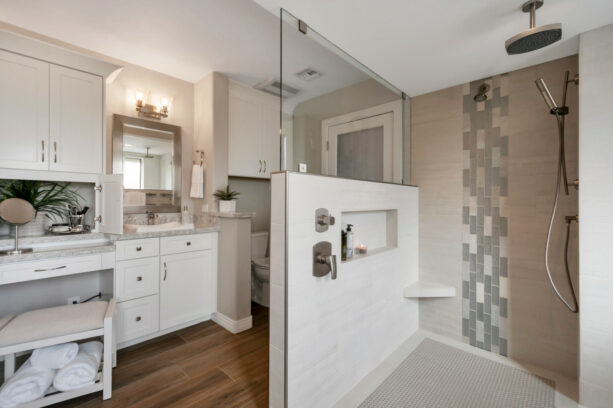
Before, the pony walls in the bathroom are used to separate the toilet from the rest of the area. This one is the same, but it has another function, too.
The pony wall in this bathroom shows that you should be creative to make the most of it because it would be a waste if you simply used your pony wall as a divider only.
The designer managed to create a niche in the pony wall. This wall is used to enclose the shower stall, to begin with. So the niche was added to the wall, clearly used to store the toiletries.
This way, no need to use a rack that can create clutter.
Besides, you can see that there are the brushed nickel finished controls in this pony wall that are meant to operate the showers.
It’s possible to install the controls conveniently on the pony wall, even though the shower is on the opposite side. It will enhance the functionality of this wall and keep the rest of the wall clear.
Like any typical pony wall in bathrooms, this one is also completed with a glass panel. The pony wall is used to support this glass panel, so it can fully cover one side of this shower area.
Similar to the shower wall tile, this pony wall is also covered with 12×24 Cemento Bianco Cassero in a beige color completed with dark tan trim.
6. Pony Wall with a Built-in Bench

This is another best way to make the most of a pony wall in a bathroom. You can make the built-in bench out of it.
A bench is useful if you have a lot of showers like this, with different functions and different streams of water.
The best way to enjoy a long shower time with a lot of showers is by sitting on a bench like this. This way, you can sit and relax and let the shower clean you up.
The pony wall is basically a border. Since this bathroom has a bathtub and showers, the excellent way to keep them separated so they won’t overwhelm the bathroom is by using a pony wall.
No need to build a tall pony wall since you can always use a glass panel to add its height. This pony wall is only 13 feet long and around 42 inches high, while the knee wall or the bench, is approximately 18 inches high.
This wall is made of gray subway tile that is used for the lower walls across the room. On the other hand, the bench is made of a different kind of tile.
Using different tile patterns for the pony wall and the built-in bench will make your shower stall look visually attractive. Just make sure that they share the same shade, though.
7. Pony Wall to Separate a Kitchen and a Dining Room
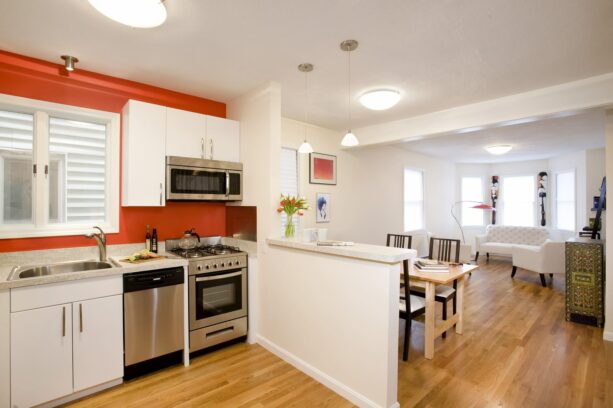
Pony walls are not only used in the bathroom but can also play their part in other rooms, in this case, a kitchen.
If you have an open floor plan, it’s essential to use a border to create zones. Sometimes the border is as simple as a rug, but sometimes you need a more solid structure to create a separator.
This pony wall is a solid border separating the kitchen and dining room.
Since it’s the kitchen, we’re talking about completed with the cabinets, base, and lowers, so the usual pony wall won’t do. It needs a taller extension to cover the upper cabinets from the dining room.
That’s why this pony wall has L-shaped. The taller part hides the upper cabinets, while the usual pony wall keeps the kitchen and dining room private.
And because this wall is used in a kitchen, so no need to cover it all with tile. This is a simple white-painted pony wall with a wider top.
The wide top is used to place some decorations. In fact, a wide top is versatile because you can use it for anything you like. It can even work as extra storage to keep some of the diner wares.
8. L-shaped Pony Wall with Two Columns

This living room is also actually part of the open floor plan. For some, adding a pony wall in an open concept room like this will only disrupt the design. But sometimes, it requires a pony wall to create zones and maintain privacy.
This pony wall has an L-shaped, making it more versatile than the usual pony walls because an L-shaped design means wider areas to cover, and you can put more things on and against it.
To make it look more majestic, the designer completed this pony wall with two columns sticking out from the two corners.
The white decorative columns go all the way up to the ceiling, clearly used more as a decoration than for a functional purpose.
There’s a console table placed against this pony wall, showing that you don’t have to build anything out of it to make the most of it. Sometimes, you have to just place some things against it to make it functional.
If you’re wondering, the pony wall is painted in Benjamin Moore – San Antonio Gray AC-29, combined with the white trim. The white shade on this wall is typical; use Sherwin Williams – Simple White or Benjamin Moore – Decorator White.
9. Recessed Panel Pony Wall to Cover the Staircase
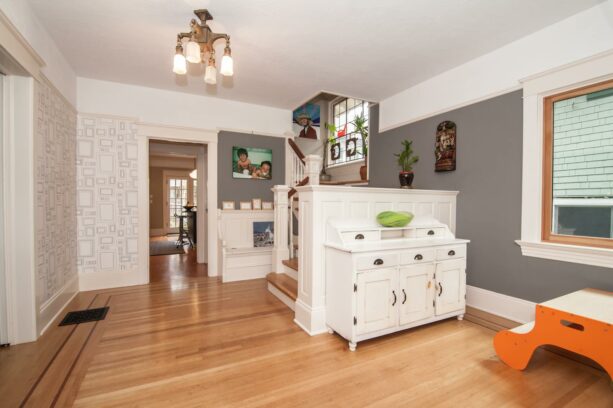
Indeed, there are many ways to use a pony wall in a room.
In this project, the designer used this elegant pony wall to cover the entrance of a staircase.
We can see that this staircase was built in the middle of the room. On its left side, there’s a kind of nook that creates a cover on one side, so it’s reasonable to create another cover for the right side to create a balance.
The designer built a pony wall to create a cover on the right side of this staircase. This way, the staircase is perfectly bracketed by these two white covers.
This pony wall is considerably smaller than the typical walls you’ve seen before. It’s because this is only meant to cover the entryway of a staircase, so the dimension follows the staircase design.
This pony wall has a recessed panel design. It’s clear that it is wainscoting, a better option to create a decorative wall panel that enhances the room’s beauty.
The designer put a similarly white cabinet drawer against this pony wall to add more balance. It’s an excellent way to decorate it.
10. A Long White Painted Pony Wall is Attached to the Opening in an Open Room

Another pony wall disrupts the open floor plan. However, this pony wall doesn’t stand alone.
Part of the opening separates the living room and the kitchen/dining room. The opening is actually a half wall. The pony wall is added to create a physical border that the opening couldn’t do.
Similar to the ceiling, this wall opening and the pony wall seem to be made of a white panel. It’s the designer’s way of creating a consistent look throughout the room and keeping the backdrop as white as possible.
To match the opening, the pony wall also has a wide top. However, the homeowners preferred to pass the option to use it as a display rack clearly to avoid the clutter.
No need to use decoration to make your pony wall look pop. You can rely on the material to attract attention. In this case, the white panel is enough.
Compared to the typical pony walls, this one is also longer.
Maybe because it’s attached to the opening, so it should be wider to create a balance, or maybe because it’s used as a place to put the couch against, so it should accommodate the shape of the couch.
Either way, this pony wall is enough to cover the room from each other.
11. Pony Wall with Wide-Gapped Wood Slats
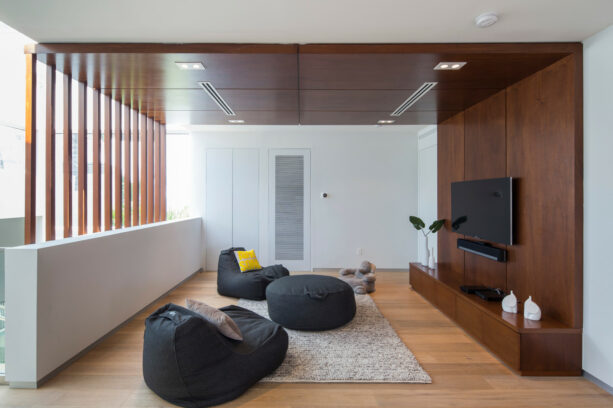
Commonly, pony walls in bathrooms are usually completed with glass panels at the top of them, while pony walls in the open concept room are usually bare with no additional panels and/or decorations. This one is there to prove it wrong.
This is a contemporary styled living room completed with a pony wall in the back. The pony wall is meant to let the living room looks more open, so it is not fully enclosed by the four walls.
The pony wall is made of the same material as the typical interior walls and is painted white. The contemporary element is the wide gapped wood slats added there.
The wood slats are basically a part of the wooden wall and the ceiling. They are connected together and extended to the pony wall.
But instead of adding full wooden panels on top of the pony wall, the designer decided to use wide gapped wood slats. This way, the openness of this living room can still be maintained.
You can see that this is actually a long pony wall. It spreads along the living room’s perimeter, leaving only the opening, the entrance.
But, the wood slats are only added to the part where it’s connected to the wood-paneled ceiling, leaving the rest of the pony wall bare and open, which is useful to let more light illuminate this living space.
12. Open Concept Kitchen with a Wood-topped Pony Wall as a Border
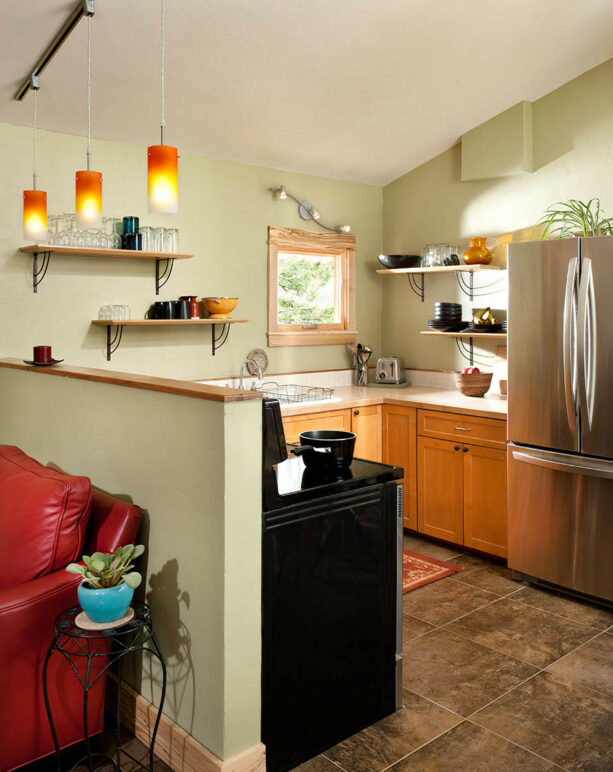
This small and simple pony wall is added to the open concept yet small kitchen.
Without the pony wall, surely the kitchen wouldn’t have had a real border, and it might have been difficult for the homeowners to create zones.
This pony wall is attached to the kitchen wall, and the height is enough to cover the entire cooking zone, so it’s invisible from the other areas in this open floor plan.
To gain consistency, the designer painted this pony wall in the same shade as the kitchen wall, which is a calming pale mint green accentuated with wood.
The pale minty green pony wall also has a wood top to complement it, repeating the same color palette from the whole kitchen. The wood top is basically narrow, but it can be used to place some decorative items.
Placing decorative items on top of your pony wall can increase privacy because it adds extra height, but at the same time, it creates clutter, too. You choose which style that you like best, clutter-free or extra privacy.
13. Decorative Wainscoted Pony Wall as Extra Storage
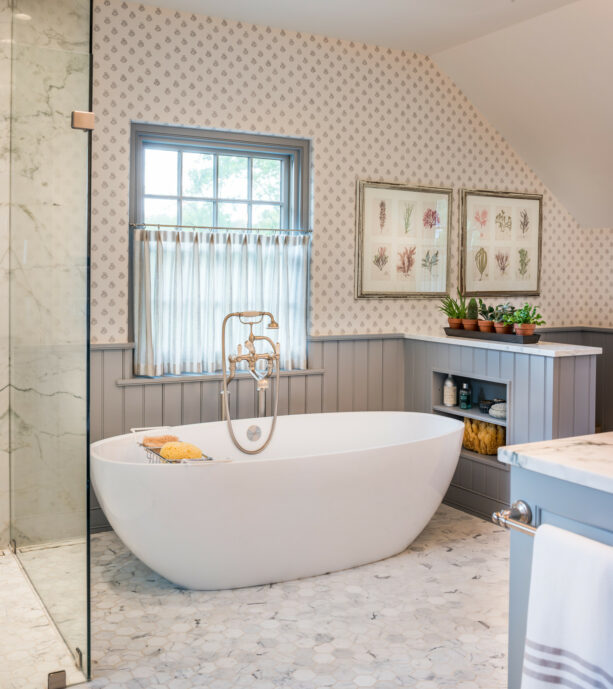
Wainscoting doesn’t only have to cover the upper main walls of the bathrooms but also the pony walls.
The pony wall in this bathroom seems like an additional part of the main walls. It is made of and covered with the same material. It has decorative wainscoting as a cover to protect it from the splashes of water.
The pattern is also similar to the rest of the walls, the simple vertical panel in gray color.
The designer wanted to make it functional as well as decorative. So, apart from being a border that separates the bath area and what it appears to be a toilet, this pony wall is also completed with a niche.
The niche is meant to be a soap niche, with two levels to hold more toiletries. This is better storage than a rack that can create clutter in your bath stall.
Plus, adding a niche near your bathtub will ease you into taking everything you need there.
This pony wall has a wide top, just like any functional pony wall. The wide top seems to be similar to the countertop of the vanity to create a visual balance throughout the bathroom.
On top of it, the homeowners could add some decorative items to liven up the room.
14. White Oak Pony Wall to Separate the Kitchen and the Living Room
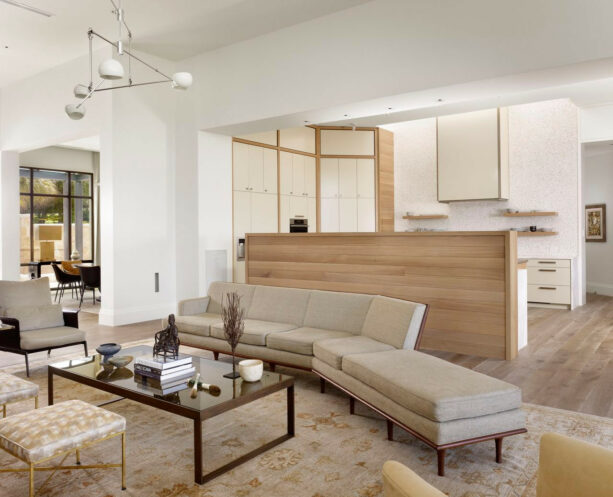
This contemporary open floor plan consists of a living room and a kitchen. To separate those two rooms, the designer built a pony wall made of white oak with a white wash finish to maintain the room’s brightness and soft tone.
The pony wall matches the other wood elements in the kitchen, which are also made of white oak. This is quite different from the other typical pony walls used as a border. Its one end is not attached to the main wall.
This pony wall like floating in the middle of the room. A floating pony wall like this adds more balance to the room.
Even though this pony wall is also completed with a top, the homeowners prefer not to add anything there. It’s a better option for pony walls which are made of or covered with attractive materials.
Let the pattern, color, or design of the wall make its own statement.
15. Pony Wall in the Entry to Partially Enclose the Living Space
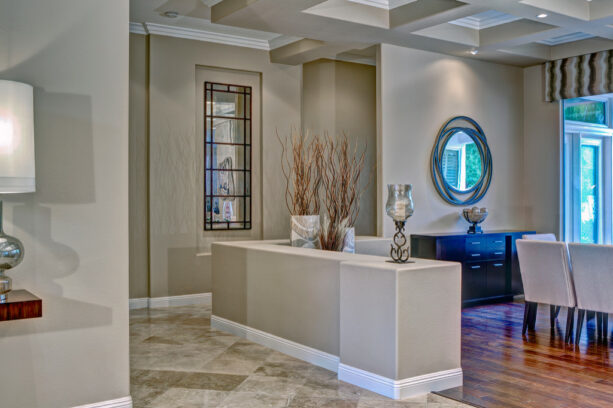
When it comes to the design, this pony wall is a bit staggered. It has a small front side that works as a “collar”, while the rest of it perfectly forms an L-shape.
This pony wall is used to partially enclose the living space and separate it from the entry.
This pony wall is connected directly to the main wall of the living space.
It seems that the homeowners wanted to keep a friendly, open, and inviting ambiance in the room. So when the visitors enter the house, they won’t see fully enclosed rooms that radiate a cool and distant feel.
This way, they can see what’s inside once they enter the house. This design is perfect for you who have an open personality.
The pony wall is also painted in a gray color, similar to the rest of the walls. According to the designer, this was a custom color that they mixed with Sherwin Williams paint.
To enhance a luxurious look, the gray wall is paired with a white baseboard as an accent.
The “collar” of this pony wall is used by the homeowners as a spot to put a vintage lamp, but the rest of the pony wall is left empty to create a clean line and clutter-free look.
Yet, the homeowners are still able to decorate it. They just placed some huge decorative vases against it to attract more attention.
16. Pony Wall in the Entrance to Separate the Mudroom and the Workspace

This is another pony wall that’s added to the entrance. However, this entrance is considerably small and less majestic than any other entry and foyer.
Remember that this shouldn’t inhibit you from adding a pony wall. Regardless of the size of the room, pony walls can always deliver their function perfectly.
This pony wall seems to be made of vinyl, clearly not meant to be an extended part of the rest of the walls. The designer wanted to make this pony wall pop, an additional element added later to serve its function.
Due to the fact that it is used for a more practical reason rather than decorative, this pony wall remains empty from any decoration.
No wonder because this area has been colorful enough.
You can see the abstract patterned wallpaper covering the accent wall and the entry door painted in a bright red shade. With those attractive elements, it’s better to keep the pony wall clean and simple.
Its one end is attached to the wall, creating a partial enclosure. This pony wall is used to separate the mud room and the workspace.
It’s unusual to add a workspace beside a mud room, right beside the entrance. However, according to the designer, this was actually a versatile room that could also be used as an additional sleeping area.
17. Pony Wall to Hide a Toilet in the Bathroom
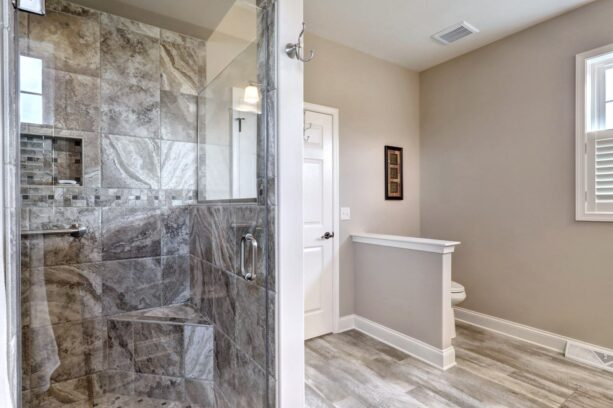
Different from the usual pony walls in the bathrooms, this one has no glass panel on top of it to create more privacy. The designer simply added the pony wall to hide the toilet from the rest of the area.
It’s quite uncommon to tuck a toilet behind a pony wall like this, separated from the other parts. When you enter this bathroom, you can choose which way to go, to the toilet or to the shower stall.
The shower stall looks large, contrasting with the tiny toilet area. But for some, it doesn’t take a large space to place a toilet, as long as it is perfectly covered, so it’s comfortable enough to finish the business.
This pony wall delivers the sufficient cover most people need for the toilet; not too enclosed but covers enough area to keep the privacy.
This pony wall is meant to be the same as the bathroom walls. Since it was built in a dry area, so no need to cover it.
It’s painted in the same greige tone as the main walls and accentuated with white baseboard and molding. It’s meant to be simple and minimalist, so it is left with no additional decorative items.


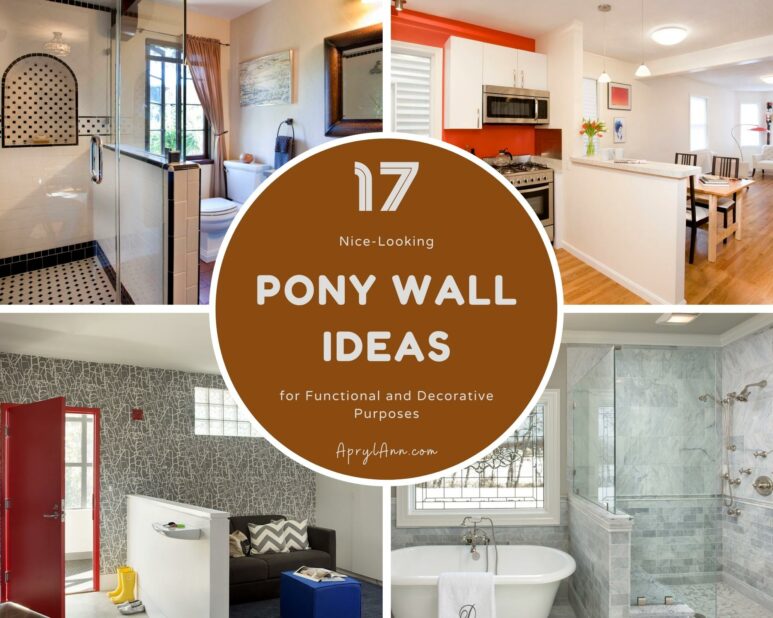
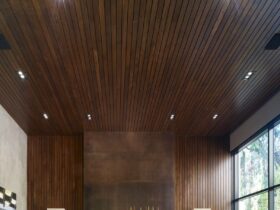
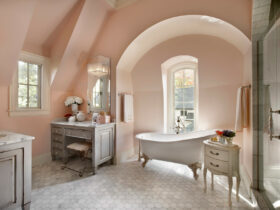
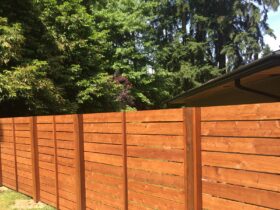
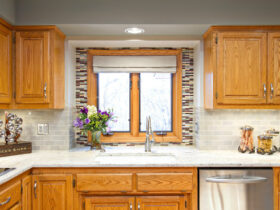
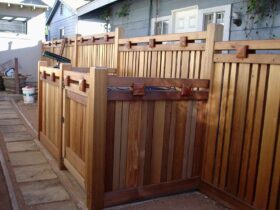
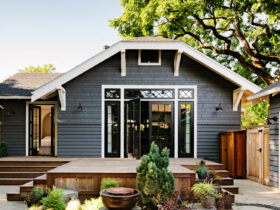
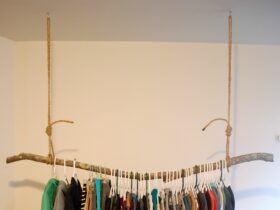
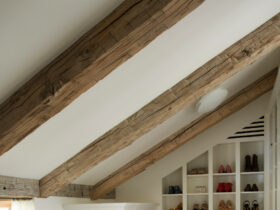

Leave a Reply
View Comments